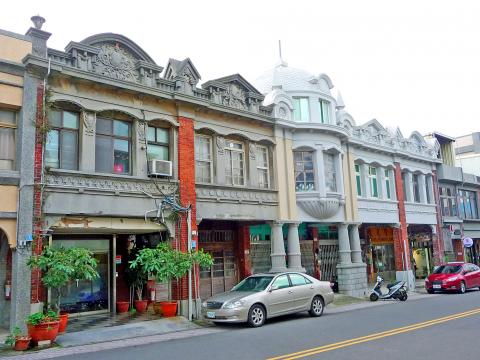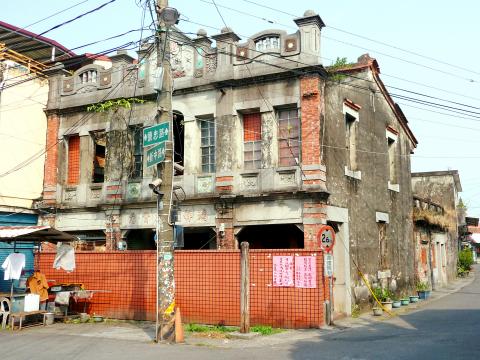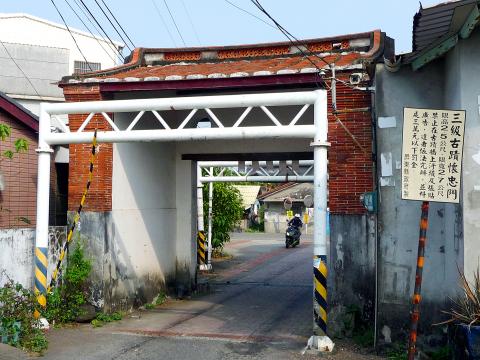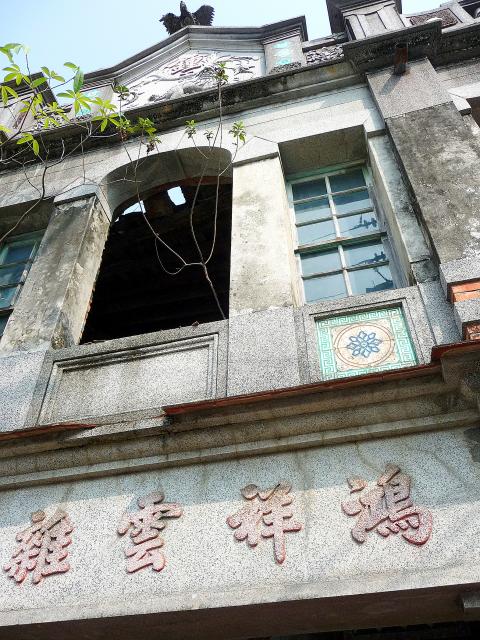The “old street” is one of Taiwan’s tourism institutions. Among the most-visited examples are Dihua Street (迪化街) in Taipei’s Dadaocheng (大稻埕) and Sansia Old Street (三峽老街) — also known as Sanjiaoyong Old Street (三角涌老街) but officially Mincyuan Street (民權街) — in New Taipei City. Several others are magnets for day-trippers and shutterbugs.
These streets were bustling commercial thoroughfares during the period of Japanese rule (1895-1945), or even earlier. As centers of gravity shifted within cities and regions, many went into decline. Hukou Old Street (湖口老街), for instance, boomed after the colonial authorities built a railway station at one end of it. However, when the railroad was relocated a few decades after World War II, businesses moved out or withered away.
Without such downturns, there would be few if any old streets. In Taiwan, places which have enjoyed recent prosperity have been extensively rebuilt. Multi-story tile-surfaced eyesores have replaced the appealing two-story shop/house combinations that characterize most old streets.

Photo: Steven Crook
I don’t begrudge anyone renovating their home or trying to make a decent living, but the impact of tourist dollars on these places isn’t always to my liking. I adore unrestored traditional buildings, and I don’t care much for crowds, so I’ve made a point of exploring Taiwan’s less well known old streets. This article is about two, one in the north, the other in the far south. Both are in areas dominated by Hakka people.
FUGANG OLD STREET
Dasi Old Street (大溪老街) is one of the most popular attractions in Taoyuan, and it’s hardly surprising. I’ve been there five or six times, and thoroughly enjoyed each visit. The architecture is gorgeous, and foodies can gorge on dried tofu. However, Fugang Old Street (富岡老街) — in Taoyuan City’s Yangmei District (楊梅區), just over 20km northwest of Dasi — has yet to be rejuvenated by tourists spending money.

Photo: Steven Crook
On a chilly afternoon at the end of winter, I stepped off the train at Fugang. I hadn’t done any proper research, so I had no idea what to expect. I could see from the map that I should walk north along Jhongjheng Road (中正路), then turn right onto Sinyi Street (信義街).
The neighborhood’s most ostentatious building is at numbers 12 to 20 Jhongjheng Road. The Fugang Lu Residence (富岡呂宅), completed in 1929, is the width of five shophouses but otherwise typical of its Baroque-influenced era.
Most of it has two floors, but at the center there’s a dome somewhat like those that adorn many colonial-era public buildings. Unfortunately, the recent cleaning of three-fifths of its exterior hasn’t enhanced the residence’s appearance.

Photo: Steven Crook
Having enough time to venture a bit further from the railway station, I walked north to Jiyi Temple (集義祠), established in 1891 and rebuilt exactly a hundred years later. Next to it, there’s a green space with some sports facilities named in honor of the local land god: It’s called Bogonggang Park (伯公岡公園).
Drifting south, I found Sinyi Street more engaging than Jhongjheng Road, and the buildings far more dilapidated. Some are almost 130 years old, and much of the wood used in their construction has rotted and fallen away. Hardly any of them seemed to house active businesses.
Had it been worth getting off the train? Yes. Will I ever come back? Perhaps not.

Photo: Steven Crook
>>Directions
Every point of interest is within 1km of Fugang Railway Station (富岡火車站), which is served by an average of three southbound local trains per hour. From Taipei, journey time is about an hour and ten minutes; one way fare is NT$81. There’s a YouBike rental point at Bogonggang Park.
FENGTIAN OLD STREET

Photo: Steven Crook
Neipu (內埔) in Pingtung County is a classic slice of rural Taiwan. The township is divided into 23 villages — one being Longcyuan (龍泉), after which Long Chuan Beer (龍泉啤酒) is named. The brewery isn’t in fact in Longcyuan, but some kilometers away in Dongning (東寧).
Another subdivision is called Fengtian (豐田), but only the western side of Fengtian Old Street (豐田老街) lies within the village of Fengtian. The eastern half of the thoroughfare is part of Jhenfeng (振豐村).
I reached Fengtian Old Street near the end of a long bike ride, and immediately noticed that this stretch of Sinjhong Road (新中路) lacks the architectural uniformity that’s a striking feature of some other old streets. Some of the older buildings have just one story, and some are set back from the road.

Photo: Steven Crook
The most eye-catching structure stands at the southern end of the old street, on the corner of Sinjhong Road and Huijhong Road (懷忠路). The former Hongsiangyun Grocery Store (鴻祥雲雜貨店) hasn’t been occupied for a long time, and a fence stops urbexers from getting inside.
Ornate yet decrepit, this two-floor landmark dates from 1924. Parts of the roof have fallen in, yet the eagle at the highest point of the facade remains intact and in place.
Also interesting is the equally old, narrower, but possibly slightly taller shophouse across the road at number 83. A mom-and-pop store operates downstairs.

Photo: Steven Crook
Upstairs, there’s a balcony where the letter “S” appears 30 times in the metal railing. This alludes to the building’s name, Kun Xie Sheng (坤協盛), which appears in Chinese characters high on the front, between two golden lion motifs. Above the Chinese, there’s Latin script reading “Kun Hsia Sheng.”
What the frontispiece lacks in width, it makes up for in ornamentation. Triangles and pinnacles point to the sky. Unfortunately, because of the sun’s position, I wasn’t able to get any good photos on this side of the old street.
I decided to leave the neighborhood via Huijhong Road, where a sign pointed the way to the East Gate of Sinbeishijhuang (新北勢庄東柵門), about 600m away. Back in the mid-18th century, when much of Taiwan was a violent frontier society, the residents of Sinbeishijhuang (the community’s former name) maintained a defensive wall of thorny bamboo.
The barrier was later upgraded to a stone wall. Three entrances were constructed, of which the East Gate is the only one still standing. There are size restrictors on both sides of the gate, so I guess it’s been damaged by vehicles that were too high or too wide — literal collisions of modernity and history.
>>Directions
The nearest bus stop, called Fengtian, is on Highway 1 (台1線), 600m or so from Hongsiangyun Grocery Store. Buses which stop here include the #1773, #1780, #8231, and #8232, all of which can be boarded in Pingtung City. Travel time is typically 30 to 40 minutes.
Steven Crook has been writing about travel, culture, and business in Taiwan since 1996. He is the co-author of A Culinary History of Taipei: Beyond Pork and Ponlai, and author of Taiwan: The Bradt Travel Guide, the third edition of which has just been published.

This month the government ordered a one-year block of Xiaohongshu (小紅書) or Rednote, a Chinese social media platform with more than 3 million users in Taiwan. The government pointed to widespread fraud activity on the platform, along with cybersecurity failures. Officials said that they had reached out to the company and asked it to change. However, they received no response. The pro-China parties, the Chinese Nationalist Party (KMT) and Taiwan People’s Party (TPP), immediately swung into action, denouncing the ban as an attack on free speech. This “free speech” claim was then echoed by the People’s Republic of China (PRC),

Exceptions to the rule are sometimes revealing. For a brief few years, there was an emerging ideological split between the Democratic Progressive Party (DPP) and Chinese Nationalist Party (KMT) that appeared to be pushing the DPP in a direction that would be considered more liberal, and the KMT more conservative. In the previous column, “The KMT-DPP’s bureaucrat-led developmental state” (Dec. 11, page 12), we examined how Taiwan’s democratic system developed, and how both the two main parties largely accepted a similar consensus on how Taiwan should be run domestically and did not split along the left-right lines more familiar in

Specialty sandwiches loaded with the contents of an entire charcuterie board, overflowing with sauces, creams and all manner of creative add-ons, is perhaps one of the biggest global food trends of this year. From London to New York, lines form down the block for mortadella, burrata, pistachio and more stuffed between slices of fresh sourdough, rye or focaccia. To try the trend in Taipei, Munchies Mafia is for sure the spot — could this be the best sandwich in town? Carlos from Spain and Sergio from Mexico opened this spot just seven months ago. The two met working in the

Many people in Taiwan first learned about universal basic income (UBI) — the idea that the government should provide regular, no-strings-attached payments to each citizen — in 2019. While seeking the Democratic nomination for the 2020 US presidential election, Andrew Yang, a politician of Taiwanese descent, said that, if elected, he’d institute a UBI of US$1,000 per month to “get the economic boot off of people’s throats, allowing them to lift their heads up, breathe, and get excited for the future.” His campaign petered out, but the concept of UBI hasn’t gone away. Throughout the industrialized world, there are fears that